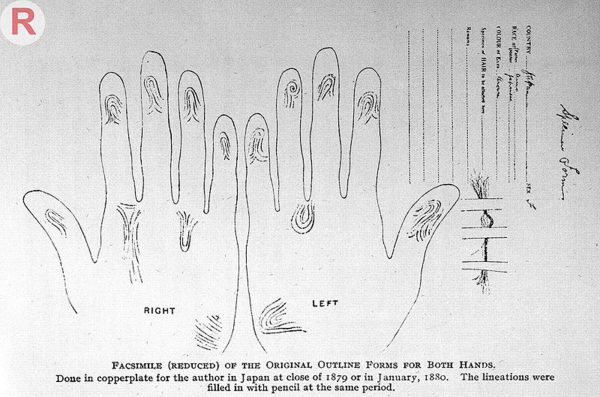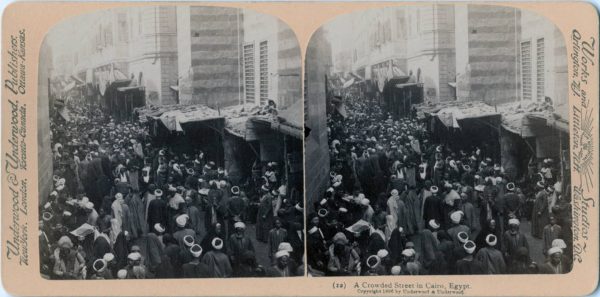Voices from the Sylff Community
Dec 6, 2023
Constructing Egypt’s Nineteenth-Century Criminal Identification System
As part of their PhD thesis, “Hygienic Enclosure and the Construction of Modern Egypt,” Marianne Dhenin details some of the scientific theories and social forces that shaped the construction of a new criminal identification system in late-nineteenth-century Egypt. Their research was supported by a Sylff Research Grant (SRG).
* * *
As a young man, Ragab el-Sayed moved from Minya to Cairo, where he earned a living shining the shoes of wealthier Cairenes and foreign tourists in the city’s bustling downtown. On July 14, 1896, at 19 years old, he was arrested, charged with committing vagabondage, and sentenced to seventeen days of imprisonment and six months of police surveillance. He spent his sentence in a local prison. Just before his release, Ragab was called to an office, where a man armed with a caliper took precise measurements of his left arm, hand, elbow, middle finger, and foot, the length and width of his head, the width of his face, the breadth of his chest, and his height. The administrator noted that Ragab had chestnut hair and brown skin with no distinguishing marks. After noting these measurements and observations in careful detail on la fiche, a two-sided form with descriptors in French, the man pressed each of Ragab’s fingertips into a dollop of ordinary printer’s ink spread thinly and evenly across a copper plate and then onto the backside of the form. When Ragab was released, he left the local jail knowing that if he were ever arrested again, he could be recognized as a recidivist and receive a harsher sentence. His intimate anatomical data was now the property of the state.
The combination of measuring and fingerprinting used to catalog those convicted of crimes in Egypt was still new when Ragab was arrested in 1896. It was the pet project of Colonel George Harvey, who served in various positions in the Egyptian police during the British occupation, which began in 1882. He had observed a similar system being tested in England while on leave in London a few years earlier. “I was so deeply impressed with the adaptability of the system to [Egypt],” he remarked, “that, on my return, I at once took it up.”
What ensued was a years-long process of developing a new identification system for Egypt, which soon extended beyond the realm of the criminalized to become a broader regime of demographic control. This essay offers a glimpse into how popular scientific theories of the time, urbanization, and migration shaped the construction and rollout of the new system.
Theorizing Crime in the Nineteenth Century
When Harvey first encountered fingerprinting in England, the methods available for classifying fingerprints remained limited, so he chose to adopt a combined classification method using fingerprints and anthropometric measurements. This latter method was called Bertillonage, after Alphonse Bertillon, the police official who introduced it in France a decade earlier.
Both Bertillonage and fingerprint identification were developed with the rise of modern criminology and penology. These nascent fields of expertise placed new emphasis on the individual human body within a broader context of discussions about criminal predisposition and the increasing traction of eugenic ideas in the popular press and scientific and legal circles. Egyptians encountered these ideas in a rash of scientific periodicals, many headquartered in Cairo, that emerged with the rise of the Arabic press in the late nineteenth century. Their readers were concentrated in the nation’s cities. They mostly belonged to a newly educated middle-class political elite and the growing cadre of civil servants and administrators who staffed the nation’s burgeoning bureaucracy. While literacy rates were low in Egypt at the time, and the circulation of periodicals remained limited, many more Egyptians engaged with the ideas in newspapers and journals at collective readings and discussions in public squares, coffee shops, and homes.
The most militant theory emerging from the late-nineteenth-century drive to individualize the criminal was that of the born criminal, promoted by subscribers to Cesare Lombroso’s school of positivist criminology. Rooted in biological determinism, the theory held that criminal behavior was an expression of atavistic human traits, and every criminal act could be traced back to some original hereditary cause—in short, criminals were born, not made. This also meant that Lombroso believed that individuals carried physical markers of criminal proclivities. Thieves had “small, wandering eyes,” for example, while rapists had “sparkling eyes” and “delicate features.”
While Lombroso’s idea of the born criminal was widely discredited across Europe in the first years of the twentieth century, it still appeared in the Egyptian press decades later. It resurfaced during the trial of Raya and Sakina, a pair of Egyptian women eventually convicted for a series of murders committed in Alexandria and hanged in 1921. Photographs of Raya and Sakina were widely circulated during the investigation and trial, and at least one prominent Egyptian commentator reflected on whether their facial features marked them as born criminals. ʿAbbas Mahmud al-ʿAqqad published his opinion on the topic after seeing the women’s photographs in al-Ahram, writing that their faces showed signs of feeblemindedness and evil. A later article, published in 1929 in the Alexandria-based English- and French-language Egyptian Gazette, turned the theory of hereditary criminality against Egyptians at large, claiming that one had only to visit any criminal court in the nation to find that the prisoners and the audience shared visible criminal features.

Several methods of fingerprint classification were developed in the late nineteenth century. This sketch showing the outline of two palms with fingerprints is from Scottish scientist Henry Faulds, who devised one early system.
Henry Faulds: Dactylography. Source: Wellcome Collection (CC BY 4.0). https://wellcomecollection.org/works/hhd5ttpp?wellcomeImagesUrl=/indexplus/image/L0032694.html.
Migration and Urbanization
Migration and urbanization also drove the development of a new criminal identification system in Egypt. The nation’s cities experienced explosive growth between 1850 and 1880, as the country’s population was growing at an approximate rate of 12 per 1,000 per year. Some cities expanded faster than others, particularly those in the Delta, like Tanta, Mansoura, and Damanhour, affected by the cotton boom of 1861 to 1866. According to census estimates, Cairo and Alexandria grew by over 40 percent during the three-decade-long period. While significant urbanization was partly a result of local population growth and rural-to-urban migration, Egypt also experienced a rise in the number of foreigners in its population during this period. These trends fostered social friction and an apparent increase in crime, as convictions for murders, gang robberies, thefts with violence, and general crimes rose in the 1890s. Harvey later estimated that Cairo accommodated almost 71,000 immigrants between 1907 and 1917. He remarked, “There is but little doubt that these ‘immigrants’ are, for the most part, undesirables who have drifted in from the rest of Egypt and are of [sic] themselves of the Criminal Class.”
To catalog groups considered suspicious, like arriving migrants, fingerprinting in Egypt was soon expanded beyond those suspected or convicted of crimes. For example, the practice of registering native servants became law in Egypt in 1902. The law required would-be domestic servants to visit the police and register with an employment agency. Using fingerprints, the police would confirm that the applicant had no previous convictions and issue an identity certificate with which they could undertake lawful employment. Various other employers, including government hospitals, the Railway Administration, and the Tram Company, later adopted this process for “certain classes of their employees.” A 1916 law added cleaners, doormen, cooks, and gardeners to the list of those required to obtain identity certificates. It also allowed workers to obtain them directly rather than interfacing with an employment agency. Later amendments added carters, couriers, and public bath attendants to the list.

The desire for a new criminal identification system intensified at the turn of the twentieth century amid increasing urbanization. Shown here is a crowded street in Cairo in 1896.
“A Crowded Street in Cairo, Egypt.” Underwood & Underwood Publishers, 1896. Stereoscopic Photographs Collection, The American University in Cairo Rare Books and Special Collections Library. https://digitalcollections.aucegypt.edu/digital/collection/p15795coll8/id/30/rec/28.
The Twentieth-Century Future of Egyptian Fingerprinting
Beginning as little more than an ambition that struck a single police official while on leave in London in the early 1890s, the Egyptian identification system became one of significant repute in less than a decade. Harvey boasted in an 1897 report that “the system as it is practiced [in Egypt] is not only exact in its details but also of international utility.” To what extent the Egyptian system may have been used as a model elsewhere is unclear. Nonetheless, Harvey and his team were on the cutting edge of developing and deploying these new technologies in the late nineteenth century.
Their European contemporaries also praised their work. John George Garson, superintendent of Scotland Yard’s Anthropometric Office, conceded in 1896 that the work of the Egypt-based team was equal to that carried out in London or Paris. Garson also reviewed a selection of about a hundred fiches compiled by measurers-in-training in Egypt and wrote to Harvey that he had “never seen a more creditable piece of work than has been turned out by your men.”
The use of fingerprinting for criminal identification in Egypt would only become more entrenched in the twentieth century, with a standalone fingerprint department eventually established under the Ministry of Public Security. With its rapid upscaling as a criminal identification system and its eventual expansion as a technology used to surveil undesirable migrant groups and large swaths of the nation’s laboring classes, the Egyptian identification system became a regime of broader demographic control in the twentieth century.
References
al-ʿAqqad, ʿAbbas Mahmud. 2013. Al-Fusul. Cairo: Hindawy Institute for Education and Culture.
Egyptian Gazette. 1902. “Crime and Village Government.” November 1, 1902.
Ayalon, Ami. 1995. The Press in the Arab Middle East: A History. Oxford: Oxford University Press.
Cole, Juan Ricardo. 1992. Colonialism and Revolution in the Middle East: Social and Cultural Origins of Egypt’s Urabi Movement. Princeton, NJ: Princeton University Press.
Elshakry, Marwa. 2013. Reading Darwin in Arabic, 1860–1950. Chicago: The University of Chicago Press.
Harvey, George. 1917–1925. Note by Colonel George Harvey on his career, upon his resignation from the position of Commandant of Cairo Police. FO 141/781/1. The National Archives, London.
Harvey Pasha, C L. 1900–1902. Letters from Colonel Harvey Pasha, Police Commandant, Cairo, to Galton. GALTON/2/9/6/13/26. Galton Papers. Wellcome Libary, London.
Hecht, Jennifer. 2012. The End of the Soul: Scientific Modernity, Atheism and Anthropology in France. New York: Columbia University Press.
Isa, Salah. 2002. Rijal Raya wa Sakina: Sirat Ijtimaʿiyya wa Siasiyya. Cairo: Dar al-Ahmadi lil-Nashr.
Khalil, Mina Elias. 2021. “A Society’s Crucible: Forging Law and the Criminal Defendant in Modern Egypt, 1820–1920.” PhD thesis, University of Pennsylvania.
Lombroso, Cesare. 2006. Criminal Man, translated by Mary Gibson and Nicole Hahn Rafter. Durham, NC: Duke University Press.
Nizarat al-Dakhiliyya. 1916. Laʾiha al-mukhaddimin. November 8, 1916. https://www.laweg.net/framePlain.aspx?action=ViewActivePages&Type=6&ItemID=36401&NID=46078.
Nizarat al-Dakhiliyya. 1902. Laʾiha bi-shaʾn al-mukhaddimin. September 20, 1902. https://manshurat.org/node/22966.
Owen, Roger. 1969. Cotton and the Egyptian Economy, 1820-1914: A Study in Trade and Development. Oxford: Clarendon Press.
Ruiz, Mario M. 2014. “Criminal Statistics in the Long 1890s.” In The Long 1890s in Egypt: Colonial Quiescence, Subterranean Resistance, edited by Marilyn Booth and Anthony Gorman. Edinburgh: Edinburgh University Press.
Takla, Nefertiti. 2021. “Barbaric Women: Race and the Colonization of Gender in Interwar Egypt.” International Journal of Middle East Studies 53 (3): 387–405.
